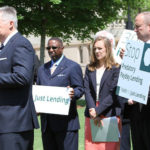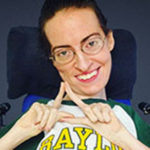TUXTLA-GUTIERREZ, Mexico (BNG)—Under a warm sun, Lluvia Citlalli Hernandez Aguilar, the sole Buckner International social worker for the Mexican state of Chiapas, makes her way down the steep gravel and rock road that descends into the Tuxtla-Gutierrez neighborhood known as Trituradora, or “Rock Crusher.”
The colonia, a mixture of one- or two-room tin and wood homes, is a rough-and-tumble area on the side of a mountain overlooking the city of Tuxtla. It received its name because of a large gravel-crushing machine at a nearby quarry. But the colonia, one of the poorest in the city, might as well be named for its ability to crush dreams.
 Strengthening families and communities is one of the goals of the Buckner program. (Photo by Russ Dilday, Buckner International)Hernandez passes several homes before entering the fenced yard of Selene Castellanos, 19. Her home is remarkable among its dreary, unpainted neighbors. It’s a mix of cinder block, a more durable construction material, and tin. The house is painted bright aqua, and the front garden lining the gravel driveway is alive with color.
Strengthening families and communities is one of the goals of the Buckner program. (Photo by Russ Dilday, Buckner International)Hernandez passes several homes before entering the fenced yard of Selene Castellanos, 19. Her home is remarkable among its dreary, unpainted neighbors. It’s a mix of cinder block, a more durable construction material, and tin. The house is painted bright aqua, and the front garden lining the gravel driveway is alive with color.
As Hernandez walks up the small drive, Castellanos greets her, accompanied by her mother, Guille. They had been selling fruit and vegetables from the racks of their miselanea, or small store, in the home’s front.
Buckner center offers hope to families
On the left, adjacent to her home, is a large, open room, where she beckons Castellanos to join her. It’s another feature that makes Castellanos’ home unique. Not only is it her home, built by local Buckner volunteers; it’s also the Buckner Family Hope Center that serves her neighbors.
Castellanos’ story also is unique. Earlier this year, she visited a nearby location where Buckner was conducting a project, asking for help for herself and counseling for her family of five, who she said were stressed.
“I met Selene sometime in May 2014,” Hernandez recalled. “I had seen her before at other events. Her family previously lived in a very different physical way; their family structure was broken. When they came to the Buckner project, we helped them so that the family could be integrated—they could have better relations between father, mother and children—and they all wanted to improve and grow as people.”
Castellanos also wanted help with the family’s home, which she described as “a disaster.”
Sign up for our weekly edition and get all our headlines in your inbox on Thursdays
Goals of the program
Strengthening families and communities is one of the Buckner program’s goals.
“Well, physically, with what we had, we were making it work. We were trying to succeed,” she said. “Yes, as a family, we needed more. We didn’t like the conditions we were in.”
The conditions were shelter-like, and their home flooded because of the slope of the land.
While the structure was in poor condition, her family life was similarly distressed.
“It was very conflictive,” she said. “We have always had our faults, but then we had more because of those conditions. We were more stressed because we didn’t like how we were living.”
Educational success
Castellanos went to the project, run out of a nearby building, for help with her education. Buckner volunteers tutored her, and the change was immediate. She began to succeed in school and, before long, started to help the children around her.
“Selene began to work with the Homework Club for the children; she would do it herself in the afternoons and then take care of and help the children,” Hernandez said, noting the majority of parents in Trituradora “don’t know how to read and write.”
Juan Carlos Millan, national director for Buckner Mexico, said he’s followed the family’s progress since they were among the first helped when work in Chiapas began two years ago.
“Her family is really different,” he said. “Her father … was never involved in things like Buckner and never involved in their home. Now they can tell you they all have more communication. They can be a family, more comfortable; they feel safe at home.”
Achieving self-sufficiency
The Castellanos family success story illustrates what Buckner Mexico hopes to do in Chiapas—help residents achieve self-sufficiency emotionally, physically, economically or educationally.
The ministry there was started in 2013 without direct financial assistance from the United States. To date, Buckner Chiapas is a model of frugality when it comes to donor-based self-sufficiency.
For Castellanos, giving back not only means volunteering as a tutor, but also serving as the host family for the Hope Center and as a donor for the land it sits on. It was her mother who suggested, as volunteers built their home, the Hope Center could occupy the front part of the land.
“For me it is a great joy, a great happiness, a blessing … a great blessing,” she said.
The Hope Center seeks to provide something for each part of the family in order to strengthen the whole through workshops and discussions among parents, Hernandez said.
Bringing about transformation
“Part of our project is to strengthen the marriage of the father and mother,” Hernandez said. “We understand that they work, but we program the activity so that they can ask for time off.”
Looking at the Hope Center and the neighborhood it serves, Hernandez reflects on what the place means to the community. It transforms families from needy clients to people who serve others.
“To build this, everybody helped. I mean everybody,” she said. “I feel it really helped Selene’s family to be more united, because it was everybody doing everything.”
Perhaps the biggest transformations aren’t just in the community but in the life of a 19-year-old woman who stepped up and asked for help for herself and her family more than a year ago.
“Because of the work here, I am more social,” Castellanos said. “I am usually in a better mood. I am more tolerant. I was the kind of person, my mother says, who would walk by with my head down and wouldn’t talk to anybody.”
But the greatest transformation is the change in her faith. Prior to working with Buckner, her spiritual condition “wasn’t very clear,” she said. “I did not know about Christ.
“Yes, I had my own concept of God, but, like everyone says, ‘I know God, and so I believe in God.’ … His love, only his love, is what transformed me completely.”













We seek to connect God’s story and God’s people around the world. To learn more about God’s story, click here.
Send comments and feedback to Eric Black, our editor. For comments to be published, please specify “letter to the editor.” Maximum length for publication is 300 words.